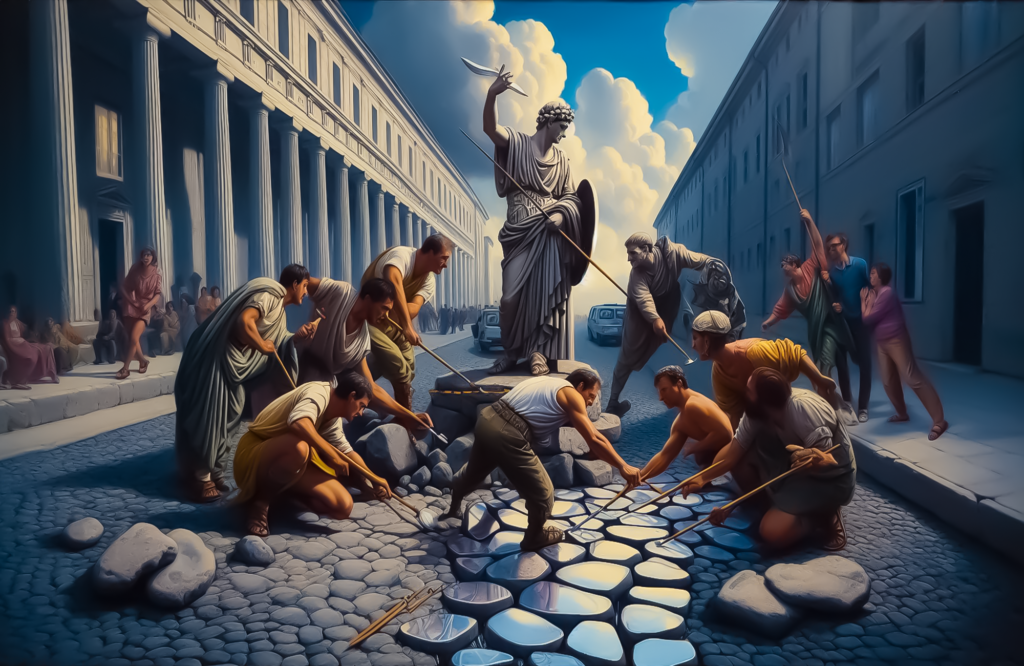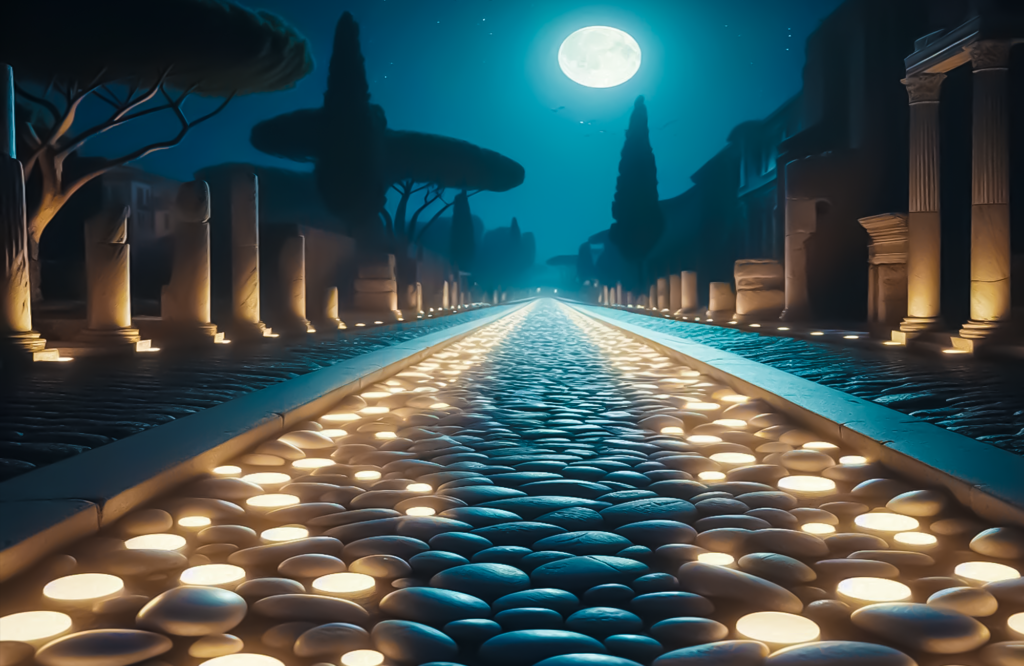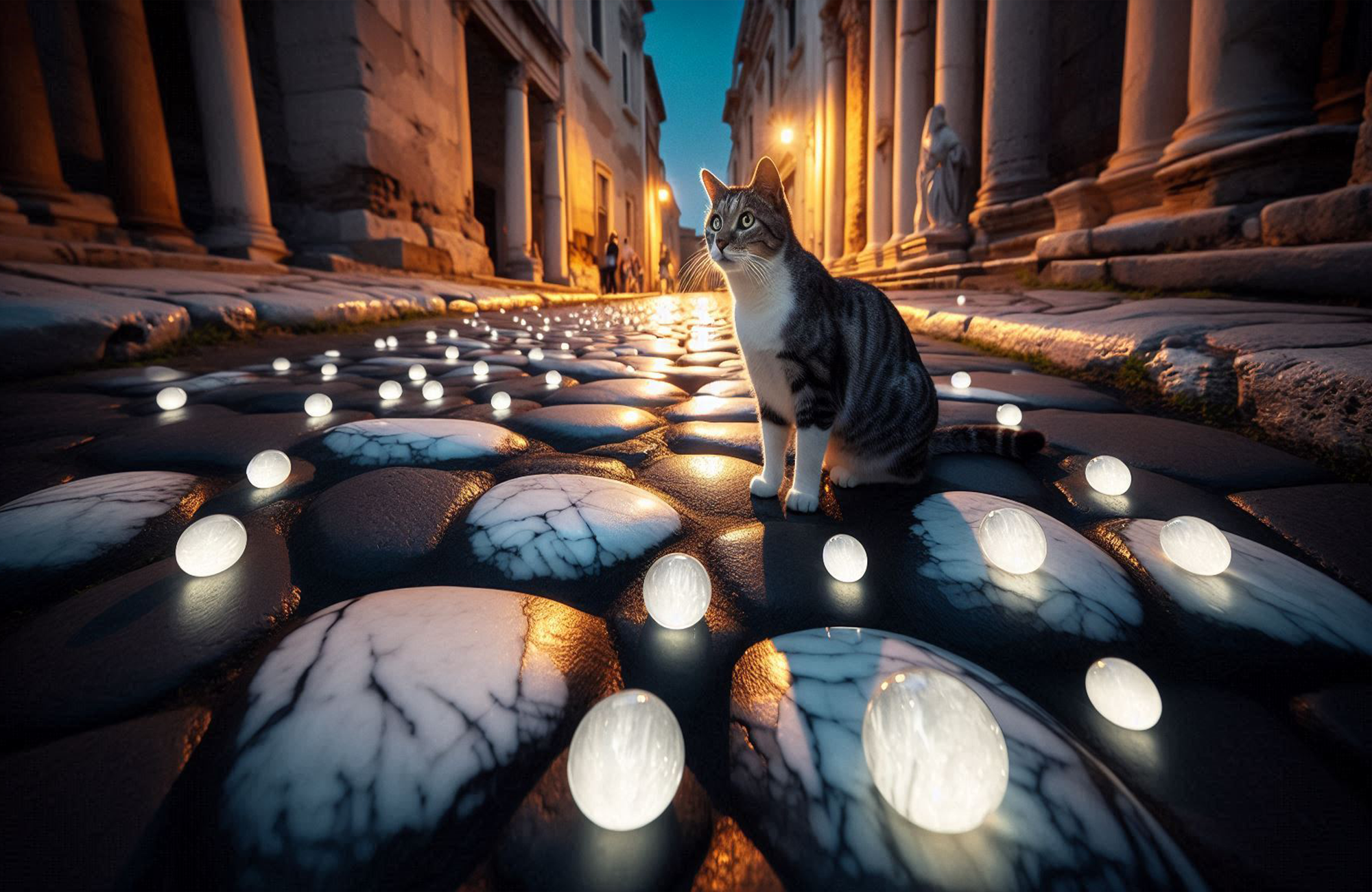The Science Behind Ancient Rome’s Moonlit Stones
Ancient Rome moonlit stones, also known as “cats’ eyes,” represent a fascinating example of early street lighting technology.
The Science Behind ancient Rome’s Moonlit Stones was a very simple.It’s a way of lighting up their roads at night without the aid of modern street lighting. These very white stones, popularly referred to as “cat’s eyes,” scattered along the roads, reflected light from the moon and stars, thereby enlightening people walking on the streets in the night. This seemingly magical phenomenon has captured the attention of numerous historians, scientists, and other people alike. But what was the science behind these reflective stones, and how did the Romans develop such an effective technique? This article talks about the magic, technique, science, and cultural significance of ancient reflective roads. It also explains how they worked and why they remain a fascinating aspect of Roman engineering to this day.
The Science Behind Ancient Rome Moonlit Stones: Historical Context
The Romans built an extended and durable network of roads across Europe, the Middle East, and North Africa. These served as a premise for the growth of the empire and the holding of territories; in fact, they were essential for trade, the movement of troops, and communication. Roman roads were feats of engineering designed to be straight, well-drained, and long-lasting. The highways was crucial due to their importance during the night as well.
Street lighting, as we consider it today, did not exist in ancient Rome. This lack of visibility made the trip quite dangerous at night and would have been hard to negotiate along the streets, always risking an accident or other crimes. To lighten these dangers, the Romans reverted to a natural solution: lining up reflective stones along their roads.
‘Cat’s Eyes’ Magic: A No-Brainer Solution
These Ancient Rome moonlit stones, more commonly known as “cat’s eyes,” functioned throughout their full potential along Roman roads, reflecting the light from the moon and stars at night to guide wayfarers. Indeed, some believe the term “cat’s eyes” comes from when a cat, in darkness, will sometimes reflect light back, giving an impression that its eyes are glowing. The stones used by the Romans reflected the ambient light to emit a relatively faint light that made it easier wayfaring people on the most difficult nights.
Such stones made of marble, quartz, or other minerals with reflective abilities; they engineers selected to return any light directed at them to its source. The idea is really quite simple: the light that came from the moon or stars falling onto stones reflected back, creating a line of faintly glowing markers along the road. This became a very efficient method, not requiring an extra source of energy to function and utilizing all natural light available in the darkness.

Science of the Reflective Stone: Light Reflection Explained
To understand how these stones worked, the most basic ways by which light reflects off a surface consider. When light strikes a surface, light is either absorbed, transmitted, or reflected. The exact amount of this light that is reflected, and the direction it takes, determine by surface properties right from its texture down to color and material.
Material composition: The stones most likely used by the Romans would have been made of materials with high reflexibility, like marble or quartz. Such minerals are extremely smooth, reflect a large portion of light, and thus were quite appropriate for the job.
Incidence angle: It should be considered that the light strikes the stone with an angle of incidence, critical for the way reflection occurs. The smoother and more polished, the better the light reflects in a predictable direction. Probably intuitive to the Roman engineers, stones would be laid at the right, most opportune angle for them to reflect maximally.
Diffuse Reflection: Contrasted with the mirrors, which would have caused a type of reflection called specular reflection, stones would have produced diffuse reflection. That type of reflection scatters the light in all directions and, therefore, permitted the stones to be illuminated, thus visible at several angles. It is this diffuse reflection that gave the “cat’s eyes” their glowing appearance, perceptible to wayfarers at various positions on the road.
Light Intensity: Their effectiveness also relied upon the intensity of the available light. The moon is a great deal less bright than the sun, though still capable of giving a reflection. This meant the stones did not have to be light sources in and of themselves; they merely had to create enough visibility to outline the road so that those who needed to travel through the night could do so safely.

The Technique: How the Romans Put in Place Reflective Stones
The Romans known as master builders their works of infrastructure meticulously. That would also have been the case with laying reflective stones on the roads. Here’s probably how they did it:
Selection and Preparation of Stones
First was the selection of the right kind of stone. The Romans would have used stones which are naturally very reflective, thus things such as white marble or polished quartz used for interiors. They cut and polished the stones to bring out the reflective properties in them. They polished the stones well because when a surface is smooth, there is more light reflected from it.
Strategic Placement
Placement was necessary for stones to work the purpose that is claimed. One imagines them recessed into the road surface at regular intervals, so there would always be one marker in view. These stones placed in a tilt or slope so that they reflected the maximum amount of light reflected from the moon and stars towards the eyes of the travelers.
Integration with Road Design
The stones must have been part of the actual road design, probably set into shallow depressions that kept them firmly in position. In this way, the stones would always be visible yet not dislodged by continuous traffic. The stones would probably range along the middle or edges of the road, demarcating the way and leading one along it.
Ease of Maintenance and Durability
Maintenance was also a strong point for this technique. Roman engineers would often service the roads, and it would not have been a surprise if that included cleaning the reflective stones and keeping them in place. The quality of the materials in use ensured that the stones would put up with the constant use and be effective for long periods.

Cultural and Symbolic Significance of the Reflective Roads
Beyond utility, such reflecting stones had a certain meaning in ancient Rome. The Roman Empireis known for emphasizing order, control, and the capacity for projecting power over long distances. In their own right, the roads represented a testament to Roman ingenuity and the reach of this empire.
Roman Ingenuity Icon
How the use of reflective stones might have mirrored the ingenuity of the Romans and the knack they had for coming up with really simple solutions to very practical problems. The stones were the monuments to how well the Romans knew the natural phenomena and how well they could bend these phenomena to suit their need.
Illumination as Metaphor
The glowing roads may have further had metaphorical meaning. Light, since time immemorial, has had connotations of knowledge, civilization, and progress. The glowing stones may denote the enlightenment so brought by the Roman Empire to conquered lands. Just as the Ancient Rome moonlit stones showed the way to travelers in darkness, so did the Roman Empire envisage itself as bringing light to a barbarous world.
Religious and Spiritual Overtones
Still, light showed the rest of its religious and spiritual implications in antiquity under Roman rule. The Romans worshipped deities related to light, among them the sun god, Sol. To this end, stones that would have been reflective of light originating from the moon and stars might have used with a potential medium of worship for such gods and, by association, connect the roads to the sacred.

Reflective Stones Today
Applying reflective stones on the roads by the Romans was an early prototype of ingenious road safety gadgets in use today. Today, the same task we use by the application of reflective paint, road signs, and markers. All these things help the people in driving and walking/running in the dark. The idea of reflection of light to gain more visibility still stays relevant but not in the same form due to advancements in technology.
Cat’s Eyes on Modern Roads
Modern “cat’s eyes,” or road studs, are a direct descendant of the Roman technique . Devised in England in 1934 by Percy Shaw, the modern versions use reflective materials for marking ways on roads at night. They, as such, form a part of the integral element of road safety in aiding the avoidance of road accidents and the organization of traffic.

Reflective clothing and gear
This principle of light reflection also works in personal safety. Reflective gears for bicycle riders, pedestrians, and construction personnel outlines the figure of the person wearing it. The result is the enhancement of visibility from the surroundings to decrease the risks of accidents or diminish its probability.
Architectural and Urban Design
Besides, the use of reflective surfaces is an age-old application in architecture and urban design that enhances the aesthetic and functional qualities of space. The use of reflection has also inspired the new works in terms of various artistic installations and several reflective building façades.
Conclusion
Ancient Rome moonlit stones exemplify Roman innovation in urban planning.Such is the outstanding example of how they, through the help of the reflective stones of the ancient Roman roads, united science, engineering, and a deep understanding of natural phenomena in a way that would solve practicable problems. That rather basic technique was really effective in keeping their roads accessible and safe even after darkness had fallen.
Designs remain very relevant to safety and design. The Roman “cat’s eyes” reflect not only the light of the moon and stars but that of Roman engineering, the enduring brilliance that continues to lighten up our world today.
In those fragments, more than anything, we remember just how timeless human ingenuity can be; how long-gone decades continue to inform and inspire today. The magic behind these reflective roads of Rome lies not in the light they could capture but in the light they shine down on our understanding of history, science, and that eternal quest for guidance into the dark.




